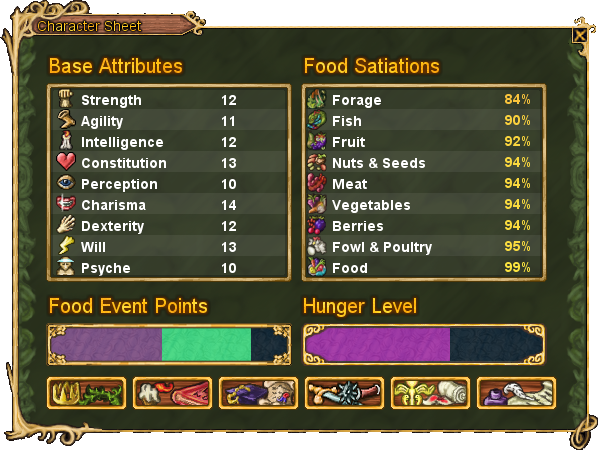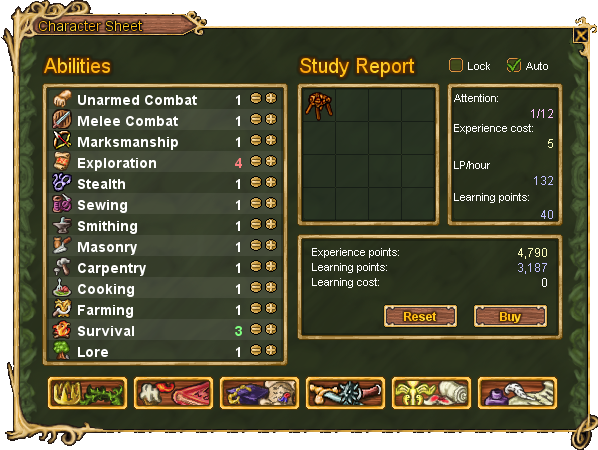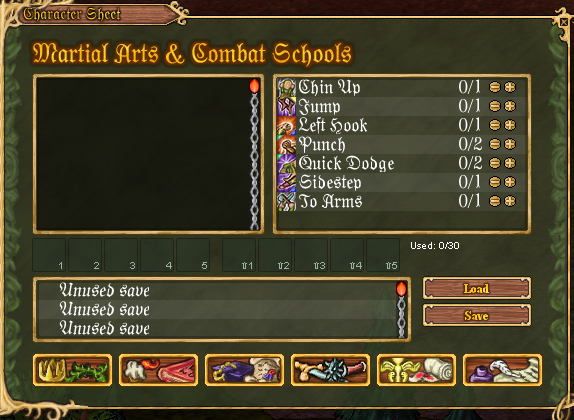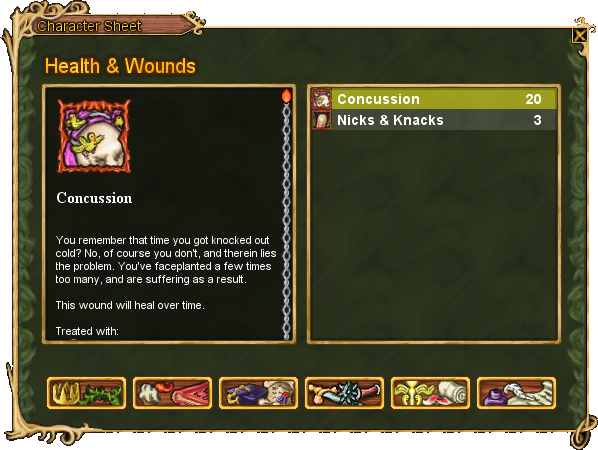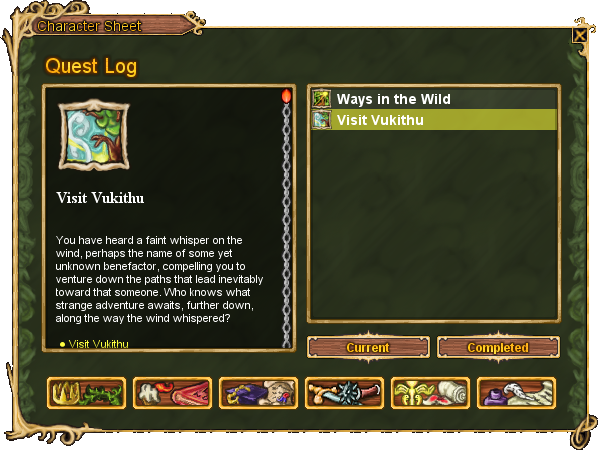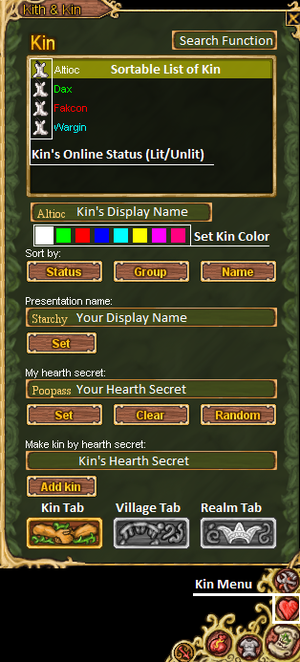Glossary: Difference between revisions
(→Energy) |
Tehepicdude (talk | contribs) m (→Study Report) |
||
| Line 38: | Line 38: | ||
Learned skills are nonrefundable, so choose wisely. Like Attributes, Abilities can be buffed or debuffed by Wounds and Equipment | Learned skills are nonrefundable, so choose wisely. Like Attributes, Abilities can be buffed or debuffed by Wounds and Equipment | ||
===Study Report=== | ===Study Report=== | ||
The Study Report is a | The Study Report is a 4x4 mental inventory, sometimes referred to as your 'mentory', used to study [[Curiosity|Curiosities]] at the cost of [[Experience Points]] to gain [[Learning Points]]. | ||
things to know: | things to know: | ||
*Studying curiosities is a passive activity and will occur automatically as long as curiosities are in your mentory. | *Studying curiosities is a passive activity and will occur automatically as long as curiosities are in your mentory. | ||
Revision as of 21:58, 7 February 2017
Character Sheet
The Character Sheet is where you can learn the most about your character. Essentially, everything about your character is displayed in these menus. this includes stats, skills, quests, and combat moves
Base Attributes
The Base Attributes page displays each of the 9 basic Attributes, as well as relevant FEP information used to determine how to best level your attributes
Attributes
Attributes are the most basic stats in Haven, and are gained through eating food and receiving Food Event Points (FEP). Attributes can be both buffed and debuffed by various mechanics in the game, such as wounds, equipment, and certain Activities
Food Event Points
The FEP bar displays the current amount of FEP you have for a specific attribute, as well as how many points are needed to gain another attribute point. Generally, the number of FEPs needed to gain a new attribute is equal to your highest attribute value. For instance, if your highest attribute is strength at 30, then you will have to consume 30 FEP to gain a new attribute point.
Food Satiations
Food Satiations are simply the percent of FEP you will receive from the base food you consume. Every food item falls into a specific food category and has a chance to satiate a food category. As such, the more of a specific type of food you eat, the fewer FEP you will receive from that food. If you have four Food satiations under 50%, the lowest satation will reset to 100%. Food Satiations can be relieved by drinking certain beverages. the maximum Satiation bonus you can receive from drinking beverages is 125%
Hunger Level
Each food has a hunger value that adds to your hunger level when eaten. Each hunger level has a lower "Food efficiency" bonuses, but takes less time to return to a lower hunger level. The hunger level of food is a flat rate unaffected by quality..
| Hunger Level | Food Efficiency | Approx time to lose 1% hunger | Approx time to lose 100% hunger | Variety Bonus | Variety Example @15 max stat |
|---|---|---|---|---|---|
| Ravenous | 300% | 2 hours | 200 hours | 1.097 | 28.3% |
| Famished | 200% | 1 hour [Verify] | 100 hours | 0.894 | 23.1% |
| Hungry | 100% | 20 minutes | 33.3 hours | 0.632 | 16.3% |
| Content | 90% | 10 minutes | 16.67 hours | 0.602 | 15.5% |
| Full | 50% | 3 minutes [Verify] | 5 hours | 0.447 | 11.5% |
| Stuffed | 25% | 46 seconds | 1.25 hours | 0.315 | 8.1% |
| Overstuffed | 10% | 7 seconds | 0.19 hours |
Abilities
The abilities page details your learned abilities, as well as earned Experience Points and Learning Points. on this page you can also manage your study report, which is where you study Curiosities
Abilities
Abilities are your Learned skills, and as such are bought using Learning Points. All abilities start at 1, and cost:
Learned skills are nonrefundable, so choose wisely. Like Attributes, Abilities can be buffed or debuffed by Wounds and Equipment
Study Report
The Study Report is a 4x4 mental inventory, sometimes referred to as your 'mentory', used to study Curiosities at the cost of Experience Points to gain Learning Points. things to know:
- Studying curiosities is a passive activity and will occur automatically as long as curiosities are in your mentory.
- Your Attention is equal to your intelligence, and determines how many curiosities you can study, determined by the curiosities' mental weight.
- You cannot have two of the same curiosities in your mentory at the same time.
- A Personal Claim Bond is kept in your mentory in order to upkeep its presence
- Once an object is finished being studied, you will receive its learning points and the object will dissapear
For more information, see the Curiosity page
Lore & Skills
Lore & Skills is where you spend learning points to buy Skills. These skills enable the ability to create and participate in certain activies, such as the ability to hunt and the ability to build boats. Skills are heirarchical, and as such, you must progress through certain skill trees before you can buy higher tiered skills. For example, before you can buy Mining, you must first purchase Stone Working.
Skills available for purchase are listed under the Available tab. Skills available, but too expensive to purchase are listed red.
Skills purchased are displayed in the Known tab.
Experience Events you have discovered are listed in the Lore Tab.
Martial Arts & Combat Schools
Martial Arts & Combat Schools is where you build, save, and examine your combat cards. Combat cards can be discovered by defeating animals in combat, as well as learned from other players.
Things to know:
- Drag and drop cards into combat slots to equip them. each combat deck can hold up to 10 different cards.
- each card has a value of one point, and each deck may have up to 30 points worth of cards.
- You may stack up to 5 of the same card in one deck. Each stacked card adds extra power to the move.
- You may have up to 5 different combat decks saved, for quick switching between decks.
- cards 1-5 are activated with keys 1-5. cards 6-10 are activated with SHIFT+1-5
Health & Wounds
Wounds are semi permanent damage taken through various activies in the game, most notably combat.
The Wounds menu displays your current list of wounds, their effects, and how to heal them. Some wounds may heal on their own, while some might need special medicine or treatments to cure them. The number displayed next to each wound indicated the humber of Hard Hitpoint damage you have received from that wound. When your Hard Hitpoints reach 0, you die. Generally speaking, wounds will not heal unless you have 8000+ Energy
Quest Log
Your Quest Log displays your Current, Completed, and Failed Quests.
Clicking a quest will display quest objectives both in menu and on screen. Having an active quest will display an arrow to the quest givers.
Equipment Screen
See Category:Equipment for all equipable items
The Equipment Screen is where players can equip their character with items that will help them flourish in the harsh world, or just look pretty. These items include weapons, armor, clothing, jewelry, tools, and healing items. There are 16 slots for equipment. Some items take up multiple slots, e.g. the Bear Cape that takes up both the headwear and cape slots, and the Pickaxe that takes up both hands. Equipment slots are unfortunately not labelled or indicated by any sort of picture in-game, making it confusing for new players to know what each slot is for. Players thus label the equipment slots using a code that combines which side of the equipment screen the slot is on and how far it is from the top, e.g. 5R is the fifth slot from the top on the right side.
Slots on the Equipment Screen
| 1L | Headwear | 1R | Necklace/Accessory | |||
| 2L | Shirt | 2R | Chest Armor | |||
| 3L | Gloves | 3R | Belt | |||
| 4L | Left Hand | 4R | Right Hand | |||
| 5L | Ring | 5R | Ring | |||
| 6L | Robe/Cloak | 6R | Back | |||
| 7L | Pants | 7R | Leg Armor | |||
| 8L | Cape | 8R | Footwear |
HUD
The Heads Up Display (HUD) provides important information about your character's current status.
Hitpoints
Hitpoints are divided into three categories, indicated in the mouse-over as SHP/HHP/MHP.
- SHP
- Soft Hitpoints. When this reaches 0, your character is knocked out, making it so you can temporarily do nothing. If your energy is over 8000, SHP will recover over time, capped by your HHP
- HHP
- Hard Hitpoints. When this reaches 0, your character dies. You can see what is lowering your current HHP in the Health tab of the Character Sheet. Some wounds will heal over time, others may require direct intervention, and yet others may not have any current healing methods.
- MHP
- Max Hit Points. Your HHP can never be greater than this number. It can only be increased by eating certain Foods that increase your Constitution attribute.
Stamina
Indicates how tired your character is. This goes down as you perform various activities, eventually making your character move slower as it goes below certain levels. Over time, your stamina will recover by taking points from the energy bar. It can also be recovered by drinking beverages, such as Water and Tea. Increasing your Constitution will reduce the drain to your stamina bar when using tools or swimming.
| Stamina % | Limitation(s) |
| < 50% | Cannot run at 4th speed. |
| < 29% | Cannot Dig. |
| < 25% | Cannot run at 3rd speed. |
| < 10% | Can only crawl. |
| < 5% | Cannot walk. |
Energy
Energy is a measure of how much work your character can do. The stamina and health bars are refilled by the energy bar. Energy is mainly consumed when you drink water to replenish the Stamina.You can get more energy by eating food.
- If your energy is 8000 or above, your energy is in "healing" state. This will regenerate your SHP.
- If your energy is 5000 or below, you are unable to do hard labor such as digging soil or mining.
- If your energy is 2000 or below, you will Starve, which will slowly drain your health and result in starving wounds.
- If your energy is 0, you will start rapidly losing HHP and die very quickly.
Speed
Speed is how fast your character moves. Generally, the faster you move, the more stamina you consume. Certain Terrains determine how fast you can run at any given time.
From left to right:
| Crawl | 1.5 tile per second. |
| Walk | 3.0 tile per second. |
| Run | 4.5 tile per second. |
| Sprint | 6.0 tile per second. |
Kith & Kin
Kin Shortcut: CTRL + B
The Kin is the love-heart button. You can add new friends here, view your current ones and quickly see their online status.
In the Hearth Secret textbox, you can create a hearth secret. When you want to make friends with people at long-distance, give them this secret and they will then be your friend, or "kin". Likewise, if somebody gives you their secret, type it in the right text area next to the one you make your own secret in. Note that Hearth Secrets are tied to your hearthling, not to your account.
You can also right click a Hearthling, "Memorize" them, then right-click "Add Kin"
The candle next to their name on the list is their online status - a lit candle is online, whilst an unlit candle means offline. However, if somebody dies, their candle will disappear.
Setting kin colors is an important feature which allows you to group kin and assign privileges, such as theft or tresspassing on Personal Claims or Village Claims
Kin Menu
In the Kin Menu, you can:
- See the online status of kin signified by a lit or unlit candle.
- Invite online kin to a party.
- Privately message your kin.
- Set your own Hearth Secret.
- Add others via Hearth Secret
- Set a Kin's color (Default is white)
- Set a Kin's Display name (For your hearthling only)
As you progress through the game, you may also find yourself cheiftain of a Village or ruler of a Realm. Both of these are also managed through the Kith & Kin Menu, through their respective tabs
Combat
Combat in Haven and Hearth is built around the deck system, with players building a deck of attack, defense and ability cards which are then drawn and selected by the player.
Unarmed Combat
See Unarmed Combat for a more detailed guide.
Unarmed combat is the first close-quarters style of fighting.
Melee Combat
See Melee Combat for a more detailed guide
Melee combat is fighting with a sword and shield or axe.
Ranged Combat
See Ranged Combat for a more detailed guide
Ranged combat is the simplest technique. Simply equip a Hunter's Bow or Sling,
Quality
See Quality for more detailed information
Almost all items, as well as many game-world objects, have a quality factor Q, which may range from 1 to ∞, with a standard default quality for most objects of 10 -- for example, all natural-growing trees are Q10. In general, higher Q items are simply better: high Q weapons do more damage, for example.
The in-game effects vary from item to item, with some items like buckets and linen clothing not having any effect at all. Where quality matters, it usually takes the form of the quality multiplier QM:
This multiplier is 1x for Q10, 2x for Q40, 3x for Q90, 4x for Q160, and so on. It is a nonlinear increase, which just means that it becomes harder and harder to get a good multiplier for higher and higher multipliers. Since Q10 has a QM of 1x, in many places on this wiki you will just see stats given for Q10 objects. You should assume this unless the wiki page you're reading says otherwise.
Softcap
Softcap is a term describing the effect of a skill on the quality of a product.
Softcaps are put into effect when the quality of a product would be higher than the skill in question. The quality of said product will then be averaged with the softcapping skill level to get the products final quality.The softcapping skill may be a single attribute or skill value, or a combination of several. If the expected quality of the product will be lower than the softcapping skill, the quality will remain unchanged.
Note:
- If more than one stat softcaps a product, the stats combine with a geometric mean, not an arithmetic mean. Ergo: used softcap value = sqrt(stat1 * stat2), rt3(stat1 *stat2 * stat3), etc.
- Quality of built objects is solely determined by the quality of their parts. Softcaps do not apply.
Example 1:
- You are creating a Treeplanter's Pot with clay of average quality 36. However, the quality of a Treeplanter's pot is softcapped by Dexterity.
- Thus:
- If your Dexterity is greater than 36
- Resulting pot will be Q 36
- If you Dexterity is less than 36
- Resulting pot will be Q (36 + Dex) /2
Example 2:
- Anastasia intends to craft a sling. She has two pieces of Leather (q13,q13), and five pieces of String(q18, q18, 9q, 13q, 15q). The average quality of the leather is 13, and the average quality of the string will be 14(14.6, rounded down to 14). The potential maximum quality of her sling will be 13 (13.5 average of leather and string, rounded down to 13).
- If Anastasia's Survival is 13 or higher, then her final produced Sling will have a quality of 13, the maximum quality possible from the material used.
- If Anastasia's Survival is lower, then her final produced Sling will be the average of her Survival and the potential maximum quality of her Sling.
- If her Survival is 10, then the final Sling quality will be 10 plus 13, divided by two: 11.5, rounded down to 11. So her final produced Sling will have quality 11.
Hardcap
Similar to Softcap, Hardcap is a term describing the effect of a skill on the quality of a product.
Hardcaps take effect when the quality of a product would be higher than the hardcapping skill. The quality of said product will be limited to the hardcapping skill's level.
Example:
- You are creating a Treeplanter's Pot with clay of average quality 36. However, the quality of a Treeplanter's pot is hardcapped by Dexterity.
- Thus:
- If your Dexterity is greater than 36
- Resulting pot will be Q 36
- If you Dexterity is less than 36
- Resulting pot will be equal to your Dexterity
Miscellaneous
Size
How many squares an object takes up. The first number refers to the x or horizontal direction, the second to the y or vertical direction. When talking about objects, size refers to how much inventory space it takes up, whereas when talking about structures it refers to the number of tiles it occupies.
